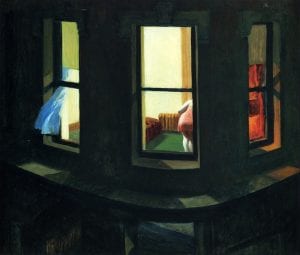Communicative English class about portals and prepositions of movement featuring an iconic pop video and the work of visual artist Michael Patterson
I’m a big fan of portals into other dimensions. Watching the David Lynch/Mark Frost television series Twin Peaks on BBC2 in my second year of secondary school was something of a gateway drug – if you’ll pardon the pun – to all manner of strange and surreal culture. Dale Cooper’s final disappearance into the Black Lodge, a kind of purgatorial antechamber peopled by backwards-speaking dwarves and taciturn giants, tapped into a long tradition of portals into other realms, notably in children’s literature, horror and science fiction. Continue reading






 Edward Hopper, Night Windows, 1928.
Edward Hopper, Night Windows, 1928.